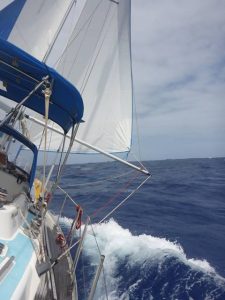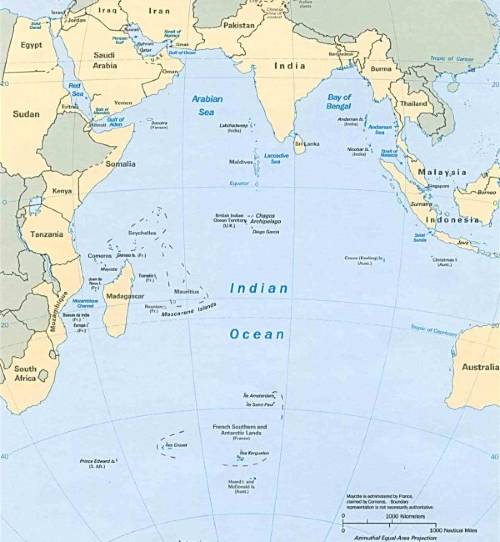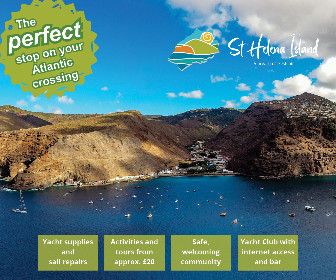Crossing the Indian Ocean Guide 2020
Des Cason is a retired cruiser based in South Africa, who offers advice to cruisers visiting the country and routing and weather information for the Indian Ocean. Des has compiled this guide for Noonsite readers based on his experience of conditions in the Indian Ocean over the past five years.
Published 3 years ago


These notes are not intended to replace any of the excellent published cruising guides available, but is my experience of the conditions over the past 5 years.
During this time I have guided and supplied weather forecasts to 450+ yachts coming across to Africa from MalaysiaIndonesia and Australia all the way to Cape Town without mishap.
It is also a summary of the conditions the yachts have experienced and my thoughts on tactics and routing, bearing in mind that my primary concern is safety and the desirability and attraction of any particular destination is a side issue.
Timing:
The general wisdom and common sense implies departure from the east from MarchApril as the SE trade winds below the equator eliminate the chances of cyclones and the onset of the SW monsoon north of the equator.
As a rule the SE trade sets in with a vengeance from end AprilMay, so any detour via Sri LankaMaldivesSeychelles and BIOT (Chagos) carries a penalty, as when you are ready to leave you need to get south with SESSE20+ consistent.
Weather Systems:
Everything is determined by the movement of the Inter Tropical Convergence Zone – ITCZ.
From +/- end November to March it is generally situated at +/- 6S. This area of low pressure and rising air is the main driver of the NWN monsoon above 6S and the SE trade winds below 6S.
In the ITCZ the weather is dominantly light and variable but with some violent squalls and the occasional Revolving Tropical Storm – RTS’s.
Statistically the chances of a cyclone occurring below the equator during the April – November period is slim, whereas November to end of March is prime time for these systems in the South Indian Ocean.
During the southern winter from April the ITCZ moves north and sets up the SE trade which once it crosses the equator turns more SSW and becomes the SW monsoon on the Indian sub continent.
Routing:
In the prime time for a crossing (MarchApril) the dominant wind from Malaysia is NNE and diminishes as you get further south and is replaced by the SE trade.
If you head for Sri Lanka / Maldives / India you will have light conditions with squalls at night and at times very slow progress. In order to get some wind to work with you need to get down to +/- 10-12S where the start of the SE trade should give you pretty consistent SE10-15+ (which some yachts have found boring at times!).
The formula is basically – the further south the more wind – so fast passages are invariably achieved by getting to below 12S. However heading south comes with the penalty of rough seas and pretty hostile conditions. It is not uncommon to have consistent SSESE25+ for days on end with 4m swell from 220T @ 8-10 seconds. These are not conditions to be taken
lightly and many a skipper who had ambitions of spending some time in ReunionMauritius threw in the towel at 14- 16S and diverted around the top of Madagascar and the Mozambique channel.
It all depends on your appetite for adventurehardship and discomfort.
If you are determined to experience some French cuisineculture you could stop at Mayotte, just west of Nosy Be Madagascar, and get your fix there. It’s 1st world and not as crowded and touristy as Reunion and Mauritius.
NORTHERN ROUTE
From Malaysia/Thailand via Malacca Straight /Sabang to Sri Lanka/Maldives/BIOT/Seychelles/Madagascar.
CENTRAL ROUTE
From Malaysia/Thailand/Indonesia via Sunda Straight/Bali from Lombok/Australia/Darwin to BIOT/Madagascar.
SOUTHERN ROUTE
From Malaysia/Indonesia and Australia via Christmas Island/Cocos Keeling/Reunion/Mauritius.


Recommendations:
The routes all have pro’s and con’s.
The NORTHERN route is slow and at times very frustrating as you have:
- the transition zone/period between the NWNE monsoon and the SE trade to contend with as it moves north;
- regular squalls and generally unsettled weather which can become quite tiring;
- a pretty hard drive south into the SE when you start dropping south from +-6S towards Madagascar.
The main choke point on this route is the compression zone at the top of Madagascar at Cap D’Ambre. This compression zone extends 200nm NE and in a NW direction just about to Aldabra Island and has consistent SSE25-30+ and rough and turbulent seas with current 2-3 kts from 130T @ 6-8 seconds. There is no way around it unless you are coming from BIOT. Yachts have experienced 45+kts at times and is not to be trifled with.
The CENTRAL route has the advantage of pretty consistent SE10-15 for weeks on end along 6-10S with the added advantage of approaching Cap D’Ambre from due east along +-10 – 12S when rounding the top of Madagascar. This reduces the danger and is a lot more comfortable with wind swell and current behind you.
The SOUTHERN route is for the adventurous who are prepared to sacrifice comfort and safety for speed and the French experience in Reunion and Mauritius. It is also favored by delivery skippers who are on the clock. A number of yachts each year persevere and once they get to Reunion and the crossing to South Africa looms ahead, they realize the dangers and
uncertainty and decide to rather go back north around the top of Madagascar and down the Mozambique Channel. Some realized the futility once they get to 14S – the lucky ones!.
In addition I would strongly recommend you read the article on Noonsite by Anne Lloyd on SV Sofia which spells out the dangers of the crossing from Reunion to SA.
Conclusions:
I am convinced that as this adventure, being a once-in-a-lifetime experience, it would be criminal to discard your dream to see some of the jewels of the Indian Ocean just because of one section of your trip with some serious weather. The crossing of the compression zone
at the top of Madagascar is daunting, but providing you pick the right gap down from the Seychelles (my job!), it is totally manageable in a “well found” vessel.
If your main objective is to get to Africa and game parks etc., I would take the central route and if possible stop at BIOT, which is rated together with French Polynesia and Madagascar NW coast, as the highlights (of world cruising).
If you intend getting across to Tanzania for the game parks, I would recommend you read my Tanzania cruising notes on Noonsite.
I welcome any questions and/or clarification required before you set off.
Des Cason
[email protected]
December 2020
……………………………………………………………………………………………………………………………………….
Related content:
- Madagascar and Mozambique Channel (Des Cason 2021)
- Other Reports by Des Cason on Noonsite
- Crossing the Indian Ocean Guide 2015
- Indian Ocean Cruising Bloggers
- Across the Indian Ocean to Tanzania 2020
- Indian Ocean and Red Sea Passage: Helping cruisers exchange information
……………………………………………………………………………………………………………………………………….
The opinions expressed in this article are the author’s own and do not reflect the view of Noonsite.com or World Cruising Club.
Related to following destinations: Australia, BIOT (Chagos), Christmas Island, Cocos Keeling, Indonesia, Madagascar, Malaysia, Mauritius, Mayotte, Mozambique, Reunion Island, South Africa, Tanzania, Thailand
Related to the following Cruising Resources: Indian Ocean, Routing



Useful contacts and links:
Des Cason – [email protected]
Kelvin Killian, SAMMNET – [email protected]
Indian Ocean Cruising Guide, by Rod Heikell (Imray, covers Red Sea, Indian Ocean, SE Asia)
Facebook: Crossing the Indian OceanFacebook: Seychells YachtiesFacebook: Sailing Australia to EuropeSouth Africa: Be sure to contact [email protected] to get onto the Dept. of Transport link. See SA Biosecurity for more details.
We sailed from La Réunion to South Africa in November 2020. We encountered good sailing conditions on par with other ocean crossings that we have done in the last few years.
With a good eye on the weather and a adaptive route planning the potential acceleration zone at the south tip of Madagasca is managable. We encountered easterly, north easterly and southerly winds, mostly below 20kts with the exception of the south tip of Madagasca (approx. 25kts, SE) and close to the South African cost (25-30kts NNE).